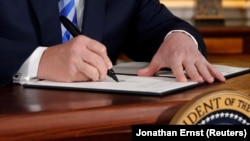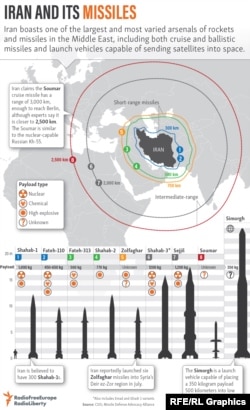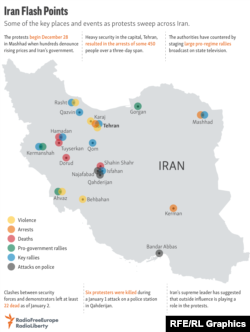In the decision of U.S. President Donald Trump to leave the nuclear deal with Iran, also known as the Joint Comprehensive Plan of Action (JCPOA), Tehran is most likely the biggest loser. JCPOA was a huge victory for the fundamentalist regime in Iran, and its unraveling represents a considerable blow to Supreme Leader Ayatollah Ali Khamenei and the status quo of Iran’s military motives in the region.
Khamenei, for his part, was so outraged by the move that he hurled personal insults at Trump for leaving the deal.
The main winners in the United States’ withdrawal are Trump -- who can say he delivered on a campaign promise -- and those in Iran who oppose the regime and want to overthrow the ruling dictatorship.
Many viewed JCPOA as a tool of appeasement by former U.S. President Barack Obama handed to Khamenei, which had a demoralizing effect on the Iranian people. It was primarily the brainchild of Obama and Khamenei, taking root through secret discussions back in 2012, which included Obama expressing acceptance and recognition of the regime in private letters to Khamenei.
Through concessions proposed by Obama and accepted by Khamenei, JCPOA unfroze an estimated $100 billion to $150 billion of Iran’s assets. More significantly, it eliminated or suspended sanctions by the United States, the United Nations, and the European Union.
On the nuclear issue, Obama conceded that the United States would allow Iran to enrich uranium on Iranian soil, which had been forbidden by several UN Security Council resolutions. He pledged to arrange the repeal of six major UN Security Council resolutions against Iran and that the United States would allow Iran to keep much of its nuclear infrastructure, as well as continue its research and development on advanced nuclear technology such as centrifuges.
In return, Khamenei agreed to allow a process wherein Iran would effectively be at least 12 months from assembling a nuclear bomb if it decided to go for a breakout.
Some opponents maintain that Obama was soft toward Iran on issues such as Syria, Iraq, ballistic missiles, human rights, and terrorism.
U.S. Congress passed sanctions on Iran over the objections of the Obama White House. The administration, however, did a phenomenal job convincing the EU and the UN Security Council to pass sanctions on Iran. These crippling sanctions played a major role in compelling the regime to come to the negotiating table.
The details of the deal were left to U.S. State Secretary John Kerry and Iranian Foreign Minister Mohammad Javad to work out. Khamenei and Zarif soon figured out that Obama and Kerry were desperate to reach a deal, and the Iranian team drove a hard bargain to win major concessions, disproportionate to the strengths of the two sides.
The deal was so one-sided that many believe it did not serve the national interests of the United States. Knowing that the deal lacked support among American lawmakers, Obama did not send it to the Senate for ratification as a treaty.
The Republicans in Congress forced a vote on the deal, and not only did it not receive 67 yes votes (as is required for a treaty), but there were actually 58 votes against it in the Senate. Four powerful Democratic senators joined all 54 Republican senators in opposing the deal. The four were Chuck Schumer (the current Democratic leader in the Senate), Bob Menendez (current ranking member of the Senate Foreign Relations Committee), Ben Cardin (then-ranking member of the Senate Foreign Relations Committee), and Joe Manchin.
In the House, 25 Democrats voted against the deal, while not a single Republican voted for it. Moreover, in another vote to extend the sanctions law on Iran that was set to expire at the end of 2016, the Senate voted 98 to 2 to extend the law, over the objection of Obama. Obama refused to sign the bill, and it became law without the president’s signature. Thus, JCPOA does not carry the force of a treaty for the United States as the overwhelming majority of American lawmakers did not consider it to be in the national interest.
With assets unfrozen and sanctions suspended, Tehran was then able to increase its oil exports from about 1 million barrels to more than 2.5 million barrels a day. Khamenei used these windfalls to drastically increase the budget for his armed forces and dramatically intensify Iran’s interventions in Syria, Iraq, Lebanon, Yemen, and Bahrain.
In Syria, for example, it is estimated that Iran spends between $6 billion and $15 billion annually to help Assad defeat his opponents. One can assume that assistance to Lebanese Hezbollah has also increased, given the armed group’s intense involvement in supporting Iran and Assad in Syria.
Iran’s economy spiraled into a severe recession due to the crippling sanctions that went into effect in 2012. After JCPOA, though, Iran’s GDP growth turned positive. But since Trump began speaking out against the nuclear deal, the economy has shown signs of weakness. Stagflation is back. In 2015, one dollar was 30,000 rials. Since Trump entered the White House, Iran’s currency has depreciated, and the U.S. withdrawal from JCPOA was announced, it hit a new low. On May 10, one dollar traded for 70,000 rials on the streets of Tehran.
The mass protests that took place in cities and towns across Iran in January were signs of great political and economic dissatisfaction among a vast numbers of Iranians. They also showed that many Iranians oppose the regime’s destabilizing foreign policy. Slogans condemned the regime’s policies in Lebanon, Gaza, Iraq, and Syria. Although the regime crushed the uprising in January, protests continue. One of the slogans in March and April protests was: “They say the enemy is in the United States, but the enemy is right here [in Iran].”
As U.S. economic pressure on Iran’s fundamentalist regime increases and the economy weakens, the regime loses strength, too. As Trump’s political pressures on the regime grows, American allies in the region such as Israel, Saudi Arabia, and the United Arab Emirates become more confident in pursuing bolder actions against Iran.
An example of such bold action may be Israel’s massive attacks on about 50 IRGC bases in Syria on May 10, with about 60 air-to-surface missiles from jetfighters and another 20 surface-to-surface missiles. The 90-minute operation was a devastating and humiliating defeat for Khamenei.
The UAE has increased its actions against the fundamentalist regime by cooperating with the United States in identifying and sanctioning individuals and groups that collaborate with the IRGC in money-laundering in the UAE, where the IRGC has a large presence.
Back in the United States, Trump can claim that he stood up to the No. 1 state sponsor of terrorism that has American blood on its hands and reversed Obama’s appeasement of the regime ruling Iran. Trump’s decision to withdraw enjoys strong support among Republicans.
The U.S. government should refrain from policies that would even indirectly help the ruling minority. Instead, it should offer support to the opposition and support the demands of the people.
Trump’s strong words of condemnation of the regime will encourage many Iranians to join the protests. If such rhetoric translates into material assistance to opponents of the regime, that would further increase the ranks and power of opposition groups and undermine the clerical rulers.
Sadegh Zibakalam, a political science professor at the University of Tehran, has said, “If there was a referendum on the Islamic Republic … over 70 percent of the people would vote no to the Islamic Republic, and the officials of the regime know this, as well.” My own study has yielded similar results, namely that the fundamentalist regime has the support of about 10 percent to 20 percent of the population. In other words, more than 70 percent of the Iranian people oppose the current rulers.
It is that minority that controls the Iran’s government, resources, and wealth, using all of the means at its disposal to rule over the majority and silence their dissent.
The lesson of Syria should be clear for Khamenei, the Iranian people, and the United States. There comes a point when large numbers of people are not willing to continue being oppressed and brutalized by a repressive regime. The recent protests in Iran clearly show that the Iranian people have reached that point.
So far, 2018 has been a horrible year for Khamenei. The mass protests greatly damaged all factions of the regime, hard-line and reformist alike. The economy has deteriorated since Trump took office, and his withdrawal from JCPOA will make the situation a lot worse. Israeli attacks on IRGC bases have badly humiliated the regime, which appears more fragile than ever before. Trump’s promise of sanctions going into effect in the next 180 days will certainly further undermine the fundamentalist regime’s hold on power. What remains to be seen is what shape the actual policy of the Trump administration will take.
Although he has said he is willing to negotiate for a better deal, Trump’s effusive praise for the Iranian people and strong condemnation of the regime seem to indicate he is willing to side with the people.
If U.S. policy can bring about a regime change in Iran, that would constitute a victory perhaps equal to the downfall of the Soviet Union.
There is a feeling among Iranians that we are witnessing the beginning of the end of the fundamentalist regime. Supporters of the regime appear anxious, and opponents are more confident. The next year or two will probably witness truly historical events. Wise or unwise policies by leaders and the response of the masses will determine whether the next period resembles 1991 Soviet Union, 1994 South Africa, or 2011-2018 Syria.








